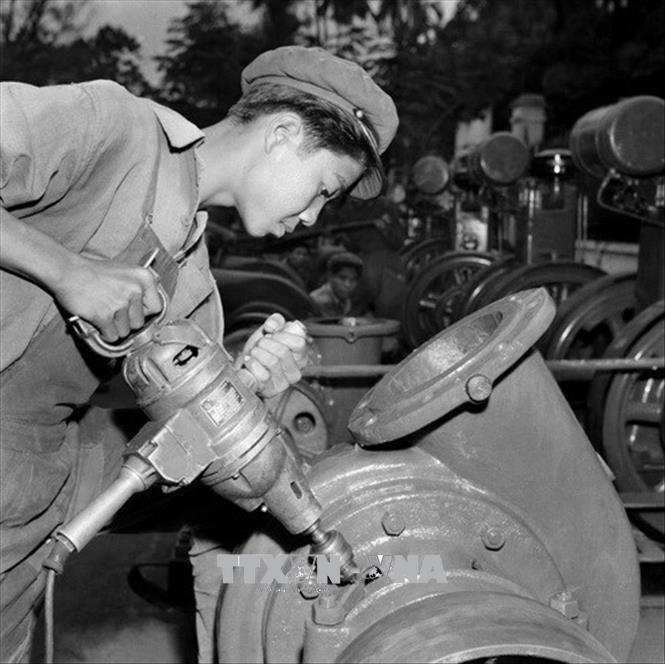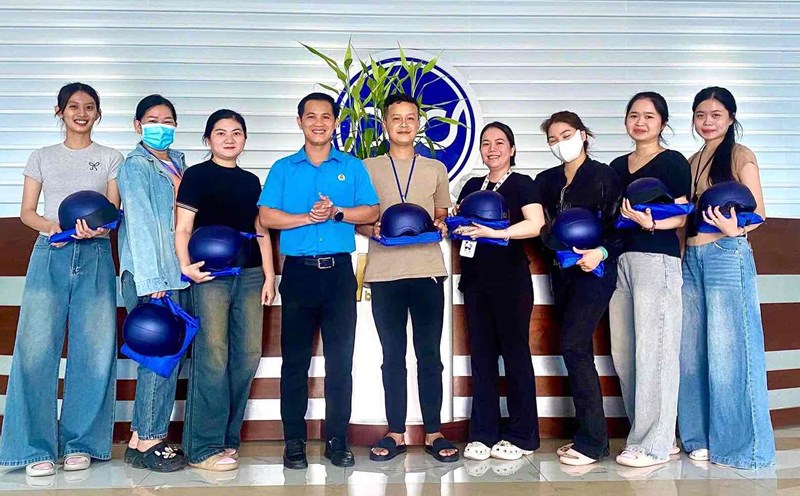After the victory over Dien Bien Phu, Vietnam was temporarily divided into two regions, the North was completely liberated and started the construction of socialism, the South was still under the domination of the US empire.
Responding to the requirements of the new situation, the Conference of the Executive Committee of the Vietnam General Confederation of Labor (term I) held in August 1954 identified the key task as "It is necessary to encourage and organize a large mass of labor in urban areas into a strong force as the best and most reliable support for the government to carry out the work of receiving and restoring production, maintaining security and order in the city".
In the North, the country's reconstruction work is being carried out, and difficulties continue to fall on the shoulders of workers. With the responsibility of the country's owners, the team of workers and civil servants has promoted production, practiced thrift, and combated waste. Thanks to that, in a short time, production activities at industrial facilities have recovered.
Through the implementation of the first 5-year plan, typical examples in the patriotic emulation movement of the working class were spread, such as " Song Duyen Hai", "Thanh Cong Cooperative", "Three Determinations"... Many outstanding employees were awarded the title of Labor Hero by the Party and State, being shining examples in studying, working in production and fighting.

In the South, the workers' and trade union movements operate in extremely difficult conditions. The American empire and flood forces have mistreated Ngo Dinh Diem into terrorism and oppression. Industrial and handicraft industries are at a standstill, the lives of workers are difficult. In that situation, the Party has directed the establishments in the inner city and in the plantations to find ways to cling to the land, cling to the people to develop forces, and organize for workers to fight.
On November 5, 5, 5, 1967, the President of the Democratic Republic of Vietnam signed Decree No. 108-SL/L10 promulgating the Trade Union Law, creating a legal basis, enhancing the position of the Trade Union organization, and consolidating the leadership role of the working class in the new situation. The success of economic recovery, socialist reform and initial economic and cultural development has created important premises to contribute to building and gradually moving the North towards socialism, while at the same time fighting for national reunification, the achievements of which have important contributions from the working class and the Vietnam Trade Union.
In response to new requirements, the 2nd Congress of the Vietnam General Confederation of Labor held in Hanoi from February 23 to 27, 61 decided to change the name of the "Vietnam General Confederation of Labor" to "Vietnam General Confederation of Labor". The Congress set a goal: "Encourage cadres, workers, and civil servants to compete in labor production, build socialism in the North with the spirit of each person working as two for the South as one, contributing to the fight for national unity".
The Congress elected the Executive Committee of the Vietnam General Confederation of Labor, consisting of 55 official members and 10 alternate members. Comrade Hoang Quoc Viet, member of the Party Central Committee, was elected as Chairman; Comrade Tran Danh Tuyen, Alternate Member of the Party Central Committee, was elected as General Secretary.
The 3rd Congress of the Vietnam General Confederation of Labor, held from February 11 to 14, 1974 in Hanoi. The Congress set the goal of "Union at all levels must launch a movement to compete in production labor, thrift in building socialism with labor productivity, work efficiency, service and participation in fighting, determination to liberate the South and unify the country".
The Congress elected the Executive Committee of the Vietnam General Confederation of Labor consisting of 72 members and the Secretariat consisting of 9 members. Comrade Ton Duc Thang, President of the Democratic Republic of Vietnam, was elected honorary President of the Vietnam General Confederation of Labor. Comrade Hoang Quoc Viet, member of the Party Central Committee, was elected as Chairman; Comrade Nguyen Duc Thuan was elected Vice Chairman and General Secretary. Comrades Nguyen Cong Hoa and Truong Thi My were elected Vice Presidents of the Vietnam General Confederation of Labor.
The Vietnam General Confederation of Labor participates in developing a number of additional and revised regimes and policies on labor, wages, and bonuses. The Trade Union Federations of provinces and cities have signed a Joint Resolution with the authorities at the same level on organizing the implementation of regimes and policies for employees. Many grassroots trade unions have promptly encouraged employees to compete in labor, production, and strive to complete assigned plans. The implementation of labor safety and industrial hygiene regulations has been better implemented, improving working conditions for employees.
In 1965, the Southern Liberation Union was established and constantly strengthened and developed, both organizing the fight for workers in cities and encouraging workers in the liberated areas to boost production to serve the fight.
During the General Offensive and Uprising of the Spring of Mouth and Spring of 1968 and the Ho Chi Minh Campaign, the Liberation Union mobilized workers in urban areas to simultaneously rise up, coordinate with armed forces to destroy the enemy, and contribute with the entire Party, people, and army to completely liberate the South and unify the Fatherland.











